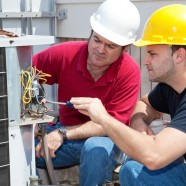
The percentage of energy you use changes depending on whether you live in southeast Florida or the northern tip of Maine, but about half of the total energy you use in your home goes directly to air conditioning and heating costs. Heating, ventilation and air conditioning, or HVAC, is also one of the most obvious ways in which to save money on home energy bills. Its usage is such a large chunk of your total energy costs, even changes that result in small percentages of savings can make a big difference. It’s the simple things that count, and taking care of small tasks that most people overlook is a great way to find HVAC energy savings all year long.
A New Thermostat
Older thermostats are often inaccurate due to extended use, plus they’re static machines. Set a thermostat at 68 degrees, and that’s where it will stay. Newer programmable thermostats have the ability to be more flexible. You program in the temperature you want during the day when you’re home, then set the temperature back another few degrees for when you’re sleeping or at work. You’ll save money by not heating or cooling the building while you’re not there, or when you’re under your covers or in front of a fan, then the thermostat’s timer will turn the temperature back to normal just in time for your home to be comfortable when you arrive. It’s a simple job for a commercial electrician to install a programmable thermostat, and the savings can pay for it in just a few months.
The Air Filter
Pull out your air filter every month and check to see if it’s dirty. If it’s soiled, throw it away and replace it with a new, clean version. Replace the filter at least every three months, but you may need a monthly replacement during heavy usage times in the heat of summer or the middle of winter. A clogged filter doesn’t allow air to pass through as easily, making the machine work harder and using more energy in the process. Replacing the air filter on a regular basis will extend the life of your HVAC system, putting off any repair or replacement costs to farther in the future.
Heating and Cooling Ducts
You can have a very well-insulated home, but if the ducts to your heating and cooling system aren’t sealed properly you’re going to lose energy from multiple points in your home. Concentrate first on the ducts that run through the harshest weather spots in your home: the attic, the crawlspace, the basement, or through an unheated garage. Use metal-backed or foil tape, or duct sealant, to seal all the seams and connections to these ducts. After they’ve been sealed, wrap them in ductwork insulation to keep them from getting hot in the summer and cold in the winter. After these ducts have all been sealed properly, find and seal any ducts in the main portion of the house.
ENERGY STAR Equipment
If your appliances are more than 10 years old, it may be time to replace them for a better running and more energy-efficient model. Do your research and compare energy usage between different models. Often the less expensive model of a refrigerator or backup generator is more expensive in the long run than those with ENERGY STAR certification. The same holds true for a new HVAC system for your home. Installing a more efficient heating and cooling system can give you significant HVAC energy savings throughout the year.
Upgrade Lighting Systems
Older fluorescent lights, as well as incandescent bulbs, put out a lot of heat while they’re being used during the day. This can result in the ambient temperature in your home or business to go up, causing the air conditioner to have to work harder. Newer LED lights are more efficient because they use less power to create the same amount of light, and they also give off a small fraction of the heat that older lighting styles do. Replace all your old bulbs with newer energy-efficient LED lights to decrease the temperature inside.

Recent Comments